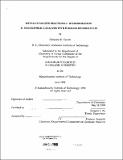Metal-catalyzed reactions.
Author(s)
Garrett, Christine E. (Christine Elizabeth), 1970-
DownloadFull printable version (10.26Mb)
Alternative title
Hydroboration
Nucleophilic catalysis with Pi-bound heterocycles
Advisor
Gregory C. Fu.
Terms of use
Metadata
Show full item recordAbstract
A variety of organotransition metal complexes (M=Rh, Fe, and Ru) were synthesized and their use in catalysis investigated. Our two principal areas of interest were in the directed, catalytic hydroboration of olefins and in nucleophilecatalyzed reactions. Indenylrhodium(olefin)2 (and other Cp-derived rhodium complexes) were utilized in the directed hydroboration reactions. Both iron and ruthenium complexes with n-bound heterocyclic ligands were utilized in the study of nucleophilic catalysis. The directed hydroborations utilized a variety of CpXRh(olefin)2 catalysts. We were interested in exploring ring slippage of the Cpx ligand to access the coordinative unsaturation necessary to accomplish a directed reaction. Generally, a 12 e- transition metal fragment is required for a directed process to occur. In the hydroboration reaction, the olefin ligands of CpXRh(olefin) 2 are rapidly hydroborated, leaving "[eta]5-CpXRh" as the active catalyst (14 e'). For a directed process to occur, the Cpx ligand must ring slip to T13, therefore providing access to the necessary 12 e- metal center. Tertiary amides were first investigated as directing groups for these reactions. The isomer expected for a directed reaction was formed under the reaction conditions. Upon further investigation, it was discovered that a facile background reaction was occurring in which the amide was reacting with the catecholborane resulting in hydroboration occurring without added metal catalysts. Furthermore, catalytic amounts of simple amides, such as dimethylacetamide, could be added to catecholborane to form an active hydroboration reagent. A range of alkylsubstituted olefins could be efficiently hydroborated under these reaction conditions. A study of the hydroboration system indicated that a BH3-amide complex is formed under the reaction conditions and that this may be the active hydroborating agent. Further study of a variety of directing groups showed that ethers might be suitable as directing groups, without causing the disproportionation of the catecholborane. Benzyl ether-directable reactions were feasible and occurred without disproportionation of the catecholborane. The reaction occurred via a metal-catalyzed pathway, and ring slippage was an important step in the directed reaction. This is the first example of a directed reaction in which ring slippage of the ligand is allowing for a coordination site to be generated and, therefore, allowing the directed reaction to occur. Our second area of interest was in investigating the use of 7-bound heterocycles as nucleophilic catalysts. Some preliminary results in our group had demonstrated the effectiveness of complexes of this type as nucleophilic catalysts. Some suitably substituted complexes were also shown to be effective asymmetric catalysts, but many other target complexes had yet to be investigated. A series of complexes utilizing N-heterocycles bound to iron fragments were prepared and investigated. The effect of electronic and steric changes on the bottom Cp ring was investigated with respect to the reactivity of the complexes. It was found that tuning the nucleophilicity of the catalyst was possible by modifying the electronics of the bottom cyclopentadienyl ring of the complex. In an effort to develop more reactive n-bound heterocycles as nucleophilic catalysts, ruthenium-derived systems were prepared and investigated. The preparation of these complexes proved to be challenging, as they were not accessible by the methodology used to prepared the ferrocene-based catalysts. Both pyrindinylruthenium and azaruthenocene complexes were prepared and found to be active nucleophilic catalysts for a variety of reactions. The pyrindinylruthenium complexes were at least as active, and in come cases more reactive, than their iron analogs. The stereoselectivity of processes utilizing these complexes was similar to that seen with the analogous iron complexes, with the exception of the kinetic resolution of secondary alcohols with acetic anhydride, which was less selective. Xray crystal structure analyses of the (DMAP*)Ru(C 5R5) complexes provided some insight into why this loss in selectivity was observed. [Pi]-Bound phospholes were also investigated. A phosphaferrocene complex was prepared and utilized as a catalyst in the ring-opening of epoxides in the presence of TMSC1. This reaction was found to be quite facile and appears to occur by a mechanism other than simple C1- ion catalysis. Some efforts towards understanding the mechanism for this reaction (i.e., nucleophilic activation of TMSC1), as well as developing chiral versions of these phosphaferrocenes, were also investigated
Description
Thesis (Ph.D.)--Massachusetts Institute of Technology, Dept. of Chemistry, 1998. Includes bibliographical references (leaves 204-205).
Date issued
1998Department
Massachusetts Institute of Technology. Department of ChemistryPublisher
Massachusetts Institute of Technology
Keywords
Chemistry